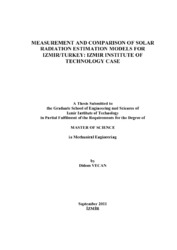Please use this identifier to cite or link to this item:
https://hdl.handle.net/11147/3163Full metadata record
| DC Field | Value | Language |
|---|---|---|
| dc.contributor.advisor | Özerdem, Mehmet Barış | - |
| dc.contributor.author | Vecan, Didem | - |
| dc.date.accessioned | 2014-07-22T13:51:00Z | - |
| dc.date.available | 2014-07-22T13:51:00Z | - |
| dc.date.issued | 2011 | - |
| dc.identifier.uri | http://hdl.handle.net/11147/3163 | - |
| dc.description | Thesis (Master)--Izmir Institute of Technology, Mechanical Engineering, Izmir, 2011 | en_US |
| dc.description | Includes bibliographical references (leaves: 45-48) | en_US |
| dc.description | Text in English; Abstract: Turkish and English | en_US |
| dc.description | xi, 53 leaves | en_US |
| dc.description.abstract | Solar energy technologies offer a clean, renewable and domestic energy source, and are essential components of a sustainable energy in the future. Proper and adequate information on solar radiation and its components at a given location is very essential in the design of solar energy systems. Due to Turkey’s location, solar energy potential is abundantly available. Consequently, it is worth to examine and conduct research on the solar energy source. In this study, the global solar radiation data in Izmir were analyzed based on 3 years of global solar radiation data measured on a horizontal surface on the campus area of Izmir Institute of Technology. Actual data readings were made on a ten minute basis from January, 2005 to December, 2007. Monthly-average daily global radiation has been analyzed. A linear, a second-order and third order equations are designed for the calculation of the monthly-average daily global radiation in Izmir. The main objective is to estimate global solar radiation via models mentioned in the literature both for Turkey in general and for Izmir specifically; and to compare the results with the three new developed models. In addition to global solar radiation, diffuse solar radiation data were analyzed and proposed models for estimating the monthly average daily diffuse solar radiation, as well. Four new models were developed for diffuse solar radiation calculations and nine models from the literature have been used. In order to confirm the results, four statistical methods have been used namely; mean bias error (MBE), root mean square (RMSE), t-statistic and relative percentage error. According to the statistical evaluation, it may be concluded that the new polynomial equation predict the monthly-average daily global solar radiance better than other available models. | en_US |
| dc.language.iso | en | en_US |
| dc.publisher | Izmir Institute of Technology | en_US |
| dc.rights | info:eu-repo/semantics/openAccess | en_US |
| dc.subject.lcsh | Solar energy | en |
| dc.subject.lcsh | Solar radiation--Turkey | en |
| dc.subject.lcsh | Renewable energy sources--Turkey | en |
| dc.title | Measurement and Comparison of Solar Radiation Estimation Models for Izmir/Turkey: Izmir Institute of Technology Case | en_US |
| dc.type | Master Thesis | en_US |
| dc.institutionauthor | Vecan, Didem | - |
| dc.department | Thesis (Master)--İzmir Institute of Technology, Mechanical Engineering | en_US |
| dc.relation.publicationcategory | Tez | en_US |
| dc.identifier.wosquality | N/A | - |
| dc.identifier.scopusquality | N/A | - |
| item.openairecristype | http://purl.org/coar/resource_type/c_18cf | - |
| item.cerifentitytype | Publications | - |
| item.fulltext | With Fulltext | - |
| item.languageiso639-1 | en | - |
| item.grantfulltext | open | - |
| item.openairetype | Master Thesis | - |
| Appears in Collections: | Master Degree / Yüksek Lisans Tezleri | |
Files in This Item:
| File | Description | Size | Format | |
|---|---|---|---|---|
| T000976.pdf | MasterThesis | 1.52 MB | Adobe PDF |  View/Open |
CORE Recommender
Page view(s)
352
checked on May 5, 2025
Download(s)
214
checked on May 5, 2025
Google ScholarTM
Check
Items in GCRIS Repository are protected by copyright, with all rights reserved, unless otherwise indicated.